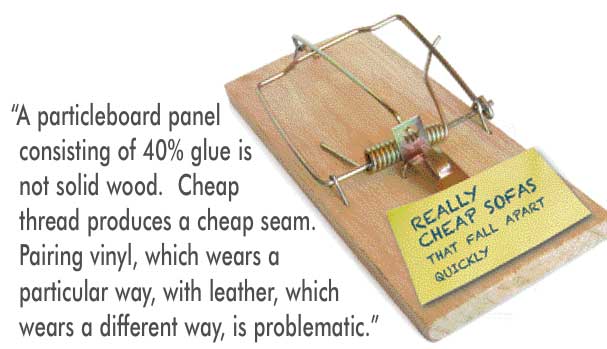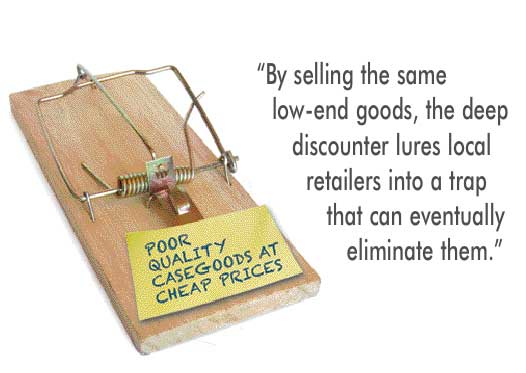Why some retailers can keep their customers after selling at the very low end, while others can not.
Have you ever tried to find a stone mason? I don’t mean a guy who spreads stucco on a concrete block wall. I mean a real, dyed-in-the-wool stone mason, from the Olde Country. Someone who understands how the rock was made, how it is split, how it interlocks. Its porosity, its density, its usefulness in different applications. Perhaps most importantly, its aesthetics, its beauty. A lot of these guys who were part of the Greatest Generation have passed away, their skills lost on those that succeeded them. Who cares--after all, they make engineered rock that looks pretty good, right?

I recently had the pleasure of speaking with Maitland-Smith’s Mr. Howard Shattuck, easily the most gifted man I’ve ever met in the furniture industry. He was given an invitation by Jim “Mattress Mack” McIngvale in Houston, Texas to speak to his salespeople. Listening to Mr. Shattuck, I discovered a real sense of disconnection between the furniture of yore and the furniture of now. The painstaking attention to detail and preservation that goes into every Maitland-Smith piece is seemingly lost on the mass market that appears to be driving the production of low-end goods. Mack understands that in order to sell higher-end goods, the salespeople need to be educated so that they can educate the customer. Maitland-Smith isn’t exactly cash and carry.
Before you dismiss this writing as another piece of altruistic, pie-in-the-sky dreaming of a shiny new stab at domestic-only production, read on. I’m not a zealot. However, I have noticed that much of the furniture we sell today bears a similarity to the likes of consumer electronics and clothing: It is disposable. I understand that not everyone can buy heirloom-quality goods. What bothers me is that we as an industry have shifted our focus away from selling good-quality furniture to selling wham-bam-thank-you-ma’am junk that inevitably fails in a short period of time, and we know it.
What does that say about us as retailers? I can only think of two reasons why a customer would decide to buy something inferior, like a cheap sofa, for example, with a useable lifespan of less than two years: They’re on a limited budget, or they don’t know any better. Given today’s economy, let’s set aside the former and focus on the latter. It’s a lot easier to push product when the price point is low (who can’t sell a sofa for $199?) and the margin is still reasonable enough to put it on the sales floor. China has put such a spit-shine on cheap goods that even relatively savvy consumers have a hard time distinguishing between high quality and low quality. The point is that the low-end product is costing you money and may inevitably destroy your business.
I firmly believe that there is a dramatic shortage of qualified furniture people in the United States. A good friend of mine and a frequent contributor to FURNITURE WORLD, Mr. Ron Wolinski, made a sharp distinction during this fall’s Market in High Point: There are those who are furniture people and work in our industry, and those that work in our industry and happen to be in furniture. Professional salespeople can flip between industries because they have the ability to separate consumers from their money, though that doesn’t necessarily mean that they understand the industry enough to maximize the sale, nor place people with the furniture that perfectly suits their needs. True morning-to-night furniture people—like Jim McIngvale--strive every day to match customers with goods that best fit their needs. Why is this important? Failed furniture equals a potentially lost customer.
Poor-quality furniture falls apart rapidly. Print finishes are susceptible to small scratches that expose the MDF or particleboard underneath to moisture. Pressboard structural components can’t endure the stress imposed on them by mechanical fasteners such as insert nuts and T-nuts. I applaud the practice of using up wood scrap by using finger joints to make longer pieces of wood, but several joints per foot is asking for trouble, especially on structural components like seat rails. And gesso? Terribly overused and inherently problematic, particularly over joints and seams. A finish should be a coating, not a crust.
One way out of our conundrum may be to help educate the consumer. Big boxes like Costco and Big Lots will always be magnets for shoppers who don’t know about furniture quality, can’t afford to buy better furniture, or want it now. These big box retailers will always try to undercut and potentially eliminate retailers who are in the same market. While service may be the deciding factor in some sales, it’s not enough to make me pay more for something. Consider this theoretical example:
Costco. Bedroom group costs $1,299. Currently in stock. No one helps me choose it. Cashier takes my method of payment but offers me terms through a Costco card application. I pick the furniture up around back, take it home, lug it upstairs and assemble it myself, and throw out the cardboard. Total cost: $1,299. When the bed falls apart I’m on my own. I’ll never buy furniture at Costco again, but I will continue to buy my groceries and other items there.
Local retailer. Same bedroom group costs $1,499. Available in two to four weeks. A salesperson helps answer questions and compare groups. Cashier takes VS/MC or in-house terms. Delivery is $79 which includes set-up and trash removal. Total cost: $1,578, or $279 more than Costco. When my bed falls apart I may or may not receive help from the retailer, though I probably won’t buy there again.
Costco doesn’t lose a customer but the local retailer does. Big boxes appeal to customers across a wide spectrum whereas a specialty retailer relies on the goods he sells and his reputation for his very existence. By selling the same low-end goods, the deep discounter lures local retailers into a trap that can eventually eliminate them. Think this is a made-up scenario? What happened to downtown America since WalMart showed up?
Lower and middle-end goods are problematic. Most casegoods furniture has a “no-rub” finish, meaning that at the end of the manufacturing process, the lacquer is allowed to dry, and then the pieces are packaged. Before there were no-rub finishes, cured lacquer was wet-sanded, rubbed with compound, and possibly buffed to a high sheen or left alone as a satin sheen. Any other type of finish was considered lower-end. This leaves today’s retailer with a challenge. First, most anyone who has purchased a no-rub finish will tell you that the appearance is so uncharacteristic, monolithic and plastic that if it is scratched or rubbed, it sticks out like a sore thumb (terrible for families with little ones). Packing marks are a huge problem for retailers, as are “angel” or light fingernail scratches, particularly on tops. In the past, we could rub these marks out with paraffin and steel wool, or maybe even some Murphy’s Oil Soap on a synthetic wool pad. If the damaged finish was high gloss, we could rub the scratch with some fine compound and buff it out. No more. Today, the only way to return a no-rub finish to its original condition is to relacquer it completely, or use a leveling agent like Mohawk’s No-Blush. Forgive me, but one cannot relacquer a piece to its original condition using a spray can. I have heard a cacophony of retorts in my days but I still insist. For me, as a professional, good enough is simply not good enough, and frankly I’m sick and tired of hearing it. For those in my discipline, it’s a cop-out.
Upholstery is a bigger problem. Most people will replace their sofa before they replace their dining room suite. Cheap sofas are made very quickly using inferior parts. Logic—simple logic—should tell any consumer that one cannot produce a sofa selling for $299 and have it hold up identically to one selling for $1,299. Bonded leather is not the same as real leather. A plank of ash is solid wood; a particleboard panel consisting of 40% glue is not solid wood. Cheap thread produces a cheap seam. Pairing vinyl, which wears a particular way, with leather, which wears a different way, is problematic. Epoxy-coated staples are not a comparable solution to double-doweling. Inadequate and inferior stuffing and foam shifts, breaks down, compacts. And please don’t get me started on cheap mechanisms.
Many people in this industry say that the market is driving the product, and I completely disagree with such an omnibus statement. The consumer may be driving low-end goods because that’s what they’re consistently being fed, over and over. A confident and professional furniture person who happens to sell furniture will help the customer choose a better product, which means fewer follow-up service calls and more repeat business. Service should be something before the sale and not after the sale.
Virtually every furniture magazine and website deals with how we can improve sales to save our businesses, as though sales are the panacea. Obviously sales are critical to any business, and we have to focus heavily on how to bring people to our stores. But as long as we continue to promote low-end goods; hire people who default customers to these low-end products rather than work a little harder to sell a finer product; and fail to match the expectations of the customer to the standards on the dock, then we have inured ourselves to the same prejudice as toys and tools: Why buy it, it’ll only fall apart.

Five Ways To Deliver Quality
Most people only need to touch a hot stove one time to realize that they don’t want to do it again. So why is it that most furniture retailers haven’t learned that selling low-quality products produces an incredible amount of pain? Why is it many retailers find it acceptable to sell “problem goods” and then deal with the resulting quality problems by hiring more customer service employees and a team of service techs. Folks, argue with me all you want, but the ultimate goal must be the perfect first-time delivery of a product that should last for several years with no service issues. That’s how you build reputation.
1. Educate the consumer and show them what they’re buying. Not everyone can afford the best so your job is to sell them the best that they can afford. No car dealer is going to start the sales process with the used cars, they’d be fired that same day!
2. Inspect the furniture and make the quality on the dock match the quality the customer expects. Stop assuming that your warehouse people already know this—most don’t, unless your dock workers happen to be married women aged 30-50 with a median income of $60,000 and two children.
3. Consider selling finer furniture with finishes that are easily serviced, like satin and gloss. Satin sheen doesn’t mean a no-rub finish with a higher reflectivity, it means a finish that has been wet-sanded and rubbed with pumice (rottenstone, compound). If your techs tell you that higher-sheen finishes are harder to fix, it’s because they don’t know how to fix them, period.
4. Empower the consumer by teaching basic touch-up, finish care, stain prevention and spill protection. A three-dollar marker is a lot easier to send out than a fully-stocked van with a $15 per hour driver.
5. Hire furniture people. Interior design students are graduating every day who will work for less money just to get themselves in the door, and sales is a great place to start. Mothers whose kids have started school may also be looking for opportunities to show off their talents after years of spooning bananas.